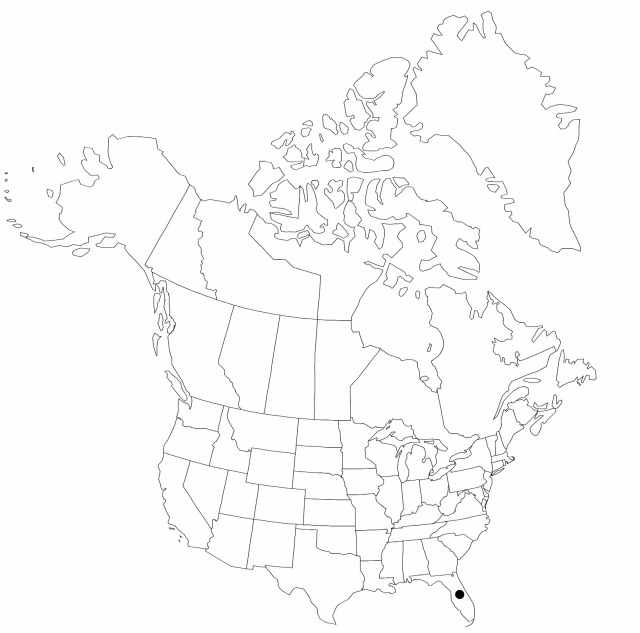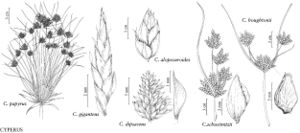Difference between revisions of "Cyperus papyrus"
Sp. Pl. 1: 47. 1753.
FNA>Volume Importer |
imported>Volume Importer |
||
| Line 8: | Line 8: | ||
}} | }} | ||
|common_names=Papyrus;Egyptian paper-reed | |common_names=Papyrus;Egyptian paper-reed | ||
| + | |special_status={{Treatment/ID/Special_status | ||
| + | |code=I | ||
| + | |label=Introduced | ||
| + | }}{{Treatment/ID/Special_status | ||
| + | |code=F | ||
| + | |label=Illustrated | ||
| + | }} | ||
|basionyms= | |basionyms= | ||
|synonyms= | |synonyms= | ||
| Line 24: | Line 31: | ||
|elevation=0–30 m | |elevation=0–30 m | ||
|distribution=Fla.;s Europe;sw Asia;Africa. | |distribution=Fla.;s Europe;sw Asia;Africa. | ||
| + | |introduced=true | ||
|discussion=<p><i>Cyperus papyrus</i> is conspicuous in the field by its great height, leafless culm, and open, hemispheric inflorescence with drooping rays.</p><!-- | |discussion=<p><i>Cyperus papyrus</i> is conspicuous in the field by its great height, leafless culm, and open, hemispheric inflorescence with drooping rays.</p><!-- | ||
--><p>Ancient Egyptians, Greeks, and Romans prepared paper from the pith of the culms of <i>Cyperus papyrus</i>, which is abundant along the Nile River.</p> | --><p>Ancient Egyptians, Greeks, and Romans prepared paper from the pith of the culms of <i>Cyperus papyrus</i>, which is abundant along the Nile River.</p> | ||
| Line 48: | Line 56: | ||
|publication title=Sp. Pl. | |publication title=Sp. Pl. | ||
|publication year=1753 | |publication year=1753 | ||
| − | |special status= | + | |special status=Introduced;Illustrated |
| − | |source xml=https:// | + | |source xml=https://bibilujan@bitbucket.org/aafc-mbb/fna-data-curation.git/src/bb6b7e3a7de7d3b7888a1ad48c7fd8f5c722d8d6/coarse_grained_fna_xml/V23/V23_287.xml |
|genus=Cyperus | |genus=Cyperus | ||
|subgenus=Cyperus subg. Cyperus | |subgenus=Cyperus subg. Cyperus | ||
Revision as of 21:32, 27 May 2020
Herbs, perennial, rhizomatous, stout. Culms roundly trigonous, 300–500 cm × 15–45 mm, glabrous. Leaves bladeless. Inflorescences: spikes loosely cylindric, 10–20 × 6–10 mm; rays 40–100, drooping or arching, slender, 10–30 cm; 2d order rays 8–20 cm; bracts 4–10, ± erect, V-shaped, 3–8 cm × 4–15 mm; 2d order bracts 2–5, (1.5–)4–16 cm × 0.5–2 mm; rachilla persistent, separating laterally, remaining firmly attached basally, wings 0.3–0.4 mm wide. Spikelets 6–30, slightly compressed, linear, ± quadrangular, 6–10 × 0.8–1 mm; floral scales 6–16, reddish beside 5-ribbed green medial part, white to hyaline near margins, ovate-elliptic, 1.8–2.2 × 1.2–1.5 mm, apex acute to obtuse. Flowers: anthers 0.8–1 mm (connectives prolonged beyond anther as red subulate appendage 0.2–0.5 mm, apex usually setose); styles 0.2–0.4 mm; stigmas 0.8–1.2 mm. Achenes pale brown, sessile, oblong, 0.8–1 × 0.4 mm, apex scarcely apiculate, surfaces puncticulate.
Phenology: Fruiting summer.
Habitat: Stream banks, marshes
Elevation: 0–30 m
Distribution

Introduced; Fla., s Europe, sw Asia, Africa.
Discussion
Cyperus papyrus is conspicuous in the field by its great height, leafless culm, and open, hemispheric inflorescence with drooping rays.
Ancient Egyptians, Greeks, and Romans prepared paper from the pith of the culms of Cyperus papyrus, which is abundant along the Nile River.
Selected References
None.
